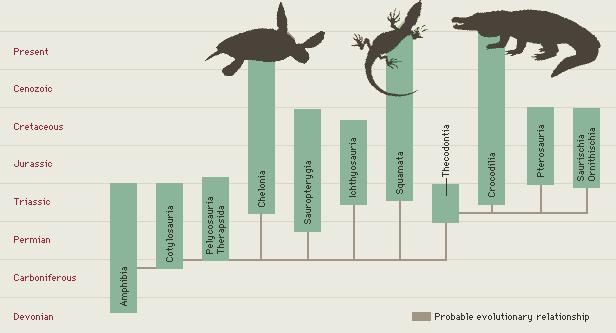Evolution of Reptiles

Special thanks to the Microsoft Corporation for their contribution to our site. The following information came from Microsoft Encarta.
While many kinds of reptiles once dominated the earth, only four orders have living representatives.
The largest of these groups is the Squamata, which includes lizards and snakes. Turtles and tortoises
belong to the order Chelonia, and crocodiles, alligators, caimans, and gavials to the order Crocodilia.
The tuatara, often called a living fossil, is the only extant member of the order Rhynchocephalia.
Prominent among extinct reptiles were the Saurischians (Tyrannosaurus and other "reptile-hipped"
bipedal carnivores), from which birds arose, and the Ornithischians ("bird-hipped" herbivores such as
Stegosaurus and Hypsilophodon). Mammals arose from the Therapsid line.

Anatomy of a Reptile
This diagram illustrates some of the important anatomical structures common to reptiles, a group that
includes snakes, lizards, turtles, crocodilians, and the tuatara. The organization of reptilian internal
organs reflects the long, narrow body structure typical of most vertebrates. Reptilian anatomy
undergoes modification in different reptile groups, adapting to the requirements of various land-based
niches. For example, the limbless reptiles-such as some lizards and most snakes-have many more
vertebrae to support movement on land.
Microsoft Illustrations, "Evolution of Reptiles & "Generalized Anatomy of a Reptile" Microsoft® Encarta®.
Copyright © 1993-2002 Microsoft Corporation.
Back to Amphibian & Reptile Index
Design by:
 Pagoda Vista
Pagoda Vista



